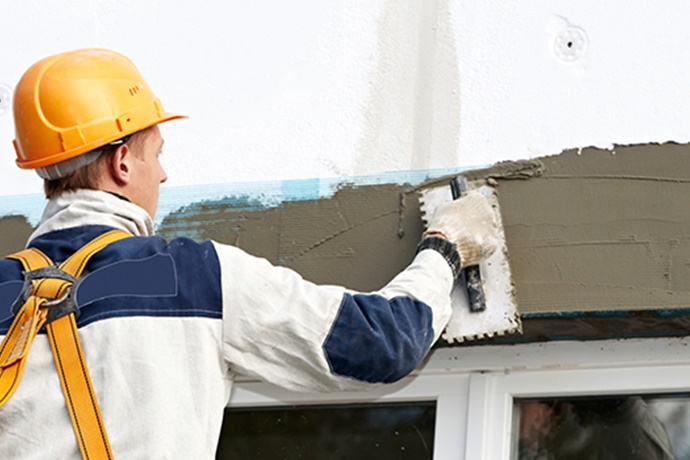Over the past several years, insurance coverage for Exterior Insulation and Finish Systems (EIFS – pronounced EE-fiss) applicators and project owners has been difficult to obtain. Clients that are involved in EIFS in any manner – including general contractors, artisan contractors, architects and engineers, owner builders, and wrap programs – should be aware of considerations in the insurance marketplace.
What is EIFS?
How EIFS is Installed
EIFS is typically attached to the outside face of exterior walls with an adhesive (cementitious or acrylic based) or mechanical fasteners; adhesives are commonly used to attach EIFS to gypsum board, cement board, or concrete substrates. The supporting wall surface should be continuous (not “open framing”) and flat.
Next Generation EIFS
How Does EIFS Lead to Insurance Losses?
Loss Examples
- There are many potential sources of water intrusion in barrier EIFS, including improper joints around penetrations, improper joints where EIFS meets dissimilar materials, and lack of proper flashings. Water can also enter the system through cracks in the face of the EIFS, regardless of how small the crack may be. Essentially, any joint or penetration in the EIFS material may be suspect.
- Any building material used on the exterior of homes will allow water or water vapor that finds its way inside to eventually escape back to the atmosphere. EIFS itself, however, blocks the movement of water and water vapor – it does not breathe. This, coupled with interior vapor barriers that are often required by building code, can lead to prolonged moisture intrusion and, eventually, rot.
Construction defect
- A broadly worded EIFS exclusion in a policy may cancel coverage, as was the situation in a 2013 federal case in which the U.S. District Court in Washington state determined in First Mercury Insurance Co. v. Miller Roofing Enterprises that the insurance company was exempt from liability for any negligence by its insured – Miller Roofing – because the policy included a broadly worded EIFS exclusion:
Mold
- The presence of moisture in a structure can lead to the growth of mold, and the vapor impermeability of EIFS creates an ideal environment for this possibility.
- Exposure to mold does not always create a health problem, but some people are hypersensitive to particular environmental exposures. Nasal congestion, eye irritation, coughing, wheezing and similar upper respiratory conditions are common symptoms of a reaction to mold exposure. More severe reactions can include shortness of breath and fever and will vary by each individual and their particular medical condition.
Underwriting Considerations (questions that may be asked and why)
- Is the contractor properly trained in EIFS installation? A properly trained contractor provides a greater assurance of correct installation. The trained contractor has knowledge and skill to handle the job correctly, resulting in the likelihood of fewer construction and insurance issues.
- Does the EIFS product the contractor uses have full code approval from the model code agency in its territory? According to the Association of the Wall and Ceiling Industry, a stamp of approval provides a marketing edge and is promoted by contractors when bidding a job. It may offer the opportunity for reduced general liability rates.
- Does the contractor primarily install drainable systems? The major issue with EIFS, as stated earlier, is moisture and/or water buildup. Drainable EIFS is among the most robust and advanced moisture-control assemblies available and underwriters are often more willing to accept these risks.
- Are there questions regarding the contractor’s quality control? Some EIFS systems fail because contractors mix and match the components from different systems. Checklists, including a defined scope of work, will help avoid errors and oversights in the process. Contractors can build certain protection into the contract documents. All contracts should be in writing.
- Location of work? Regions that are more humid will generally have greater exposure due to moisture buildups and subsequent mold growth. Examples of tougher states include Colorado, Arizona, and Florida.
Placing Coverage for an EIFS Contractor
- General Liability: General contractors (GCs) often rely on insurance coverage held by subcontractors (subs) for EIFS exposure. GCs may be held responsible for losses if the sub’s coverage is not sufficient. Including EIFS in a GC’s insurance policy will provide coverage in those cases.
- Environmental/Pollution: General liability policies for contractors generally do not cover mold-related losses. Coverage for mold can be purchased that will include all work including EIFS.
- Professional: EIFS coverage can be included in both Owner Controlled Insurance Program (OCIP) and Contractor Controlled Insurance Program (CCIP) policies. Additionally, coverage can be obtained for subs and GCs.
- Excess Liability: Most GCs carry more than the industry standard 1/2/2 limits and require their subs to do the same. Larger jobs will require excess liability coverage, and it is important to confirm that EIFS is included. Coverage is usually provided over the carrier’s own primary form.
This article was authored by Evelyn Hazenberg of AmWINS Brokerage of Michigan. Evelyn is the co-leader of AmWINS' National Environmental Practice and is available to answer questions about this article and the coverage implications.


